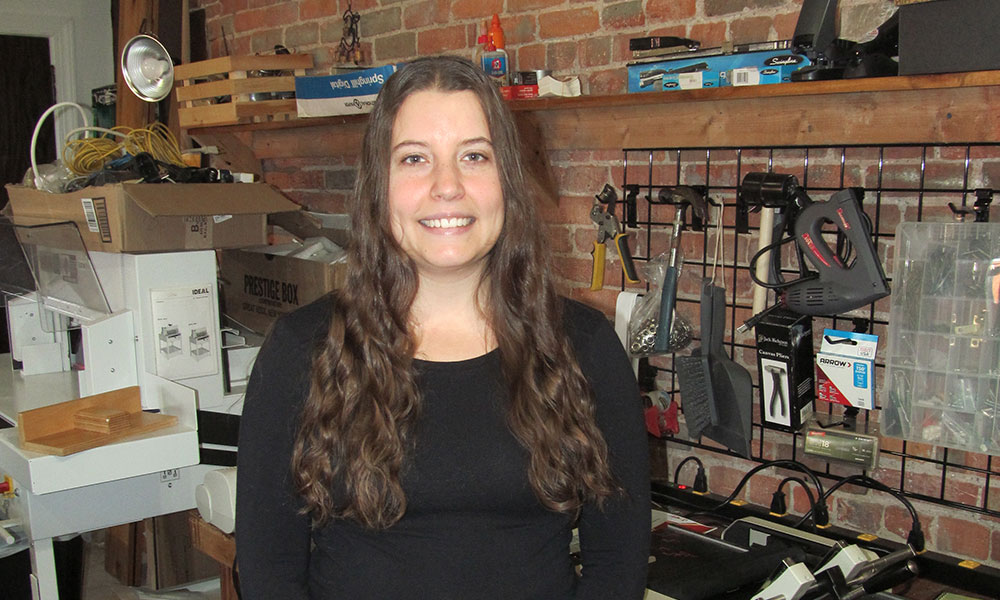Owner of Port City Copy Center in Oswego endures hardship to achieve success
By Lou Sorendo
Q.: At what point in your life did you decide you wanted to run your own business?
A.: I think it all stemmed from a career day in elementary school. All the parents were talking about what they do, and I was like, “Man, I don’t want to work for anyone else. That sounds awful.” One of the parents stood up and said, “I own my own business.” And I was like, “Bingo!” I worked full time throughout college, and I saved about $10,000 with the intention of starting my own business. I lived at home, so didn’t have many expenses. A couple of years after that, I got a loan through the city of Oswego for $20,000 to expand a little bit more.
Q.: You are a graduate of the Oswego County Micro-Enterprise Business Training Program. How did the experience help?
A.: It was huge. I earned my bachelor’s degree in business administration at SUNY Oswego, but that didn’t prepare me in the least bit like the small business program did. It taught me how to do everyday things while owning a business, such as actually meeting with bookkeepers and insurance companies. The business administration degree helped me on a theoretical basis in terms of critical thinking, but the Micro-Enterprise Business Training Program classes taught me the nitty-gritty of running a business. It’s such a great program. I wish more people knew about it. It definitely gave me a degree of comfort that I didn’t have before.
Q.: You worked at Staples prior to establishing your own business. How did that experience help you from a professional standpoint?
A.: That definitely opened up the opportunity, because I didn’t even know what a copy center was until I started working there. I enjoyed working with customers in more of a corporate setting, and was able to figure out what our city would need in a print shop versus what wouldn’t really work. Having experience from there definitely gave me the tools I needed.
Q.: How difficult was it to absorb the 2017 Memorial Day weekend fire that destroyed that block of West Bridge Street where you were located?
A.: It was very traumatizing. I am still mending emotionally from all of that. It was Memorial Day weekend and I was camping with my now-fiance. We had just started dating, love was in the air and we were having such a great time. Then I got word that a massive fire had broken out and my business was involved. I went from such a high to such a low so quickly. We were driving from Fair Haven, and we could see the smoke just barreling out from there. I was just hysterical. I tend to avoid driving down Bridge Street because my palms still get a little sweaty.
Q.: Did you consider giving up the business?
A.: There were times when I was asking myself, “Do I want to try to do something else?’ People were offering me job opportunities, and I was in position to potentially make more money. But that thought lasted a split second. I said, “I’m still invested in this and it just doesn’t feel right.” I was not ready to walk away and give it all up yet. Thankfully, I had some cash on hand, so the interim period was hard but not devastating. I was able to regroup and get my equipment going in my new location pretty quickly.
Q.: How did you end up at the Old Freight House on East First Street, between The Press Box and Port City Day Spa?
A.: We were located on the lower level of Midtown Plaza for a couple of months after the fire, but we expected that the plaza was coming down for the East Lake Commons project. This space was already open, and to move right around the corner was much easier. I myself had not come down here too often, but I am so surprised by the foot traffic there is here already. I don’t think many people know there’s a little section of downtown here that doesn’t necessarily correspond with the section of downtown on the west side. I am already impressed with how much foot traffic there is.
Q.: What do you consider to be the most difficult challenges you face today?
A.: The biggest challenge lately is a paper shortage. A lot of people don’t realize that because newspapers are not being printed like they used to, that’s caused a lot of mills to shut down. Also, there are extra tariffs at our borders. Now our prices for raw material have actually doubled. Trying to keep a margin and customers happy at the same time has been a little tricky. Printers like us have had to readjust to smaller volumes. The mills as well have to adjust to producing smaller amounts. Once they figure out how to still make money and keep their product coming out, I think we’ll see the market stabilize a little bit. When that will happen I am not sure, but hopefully soon.
Q.: How has the print industry changed during your tenure as a business owner?
A.: At Staples, we were just using standard copiers to print off flyers and things like that. That worked then, but now people are after quality. Now we are close to the quality that offset printing offers. [Offset printing is a commonly used printing technique in which the inked image is transferred from a plate to a rubber blanket, then to the printing surface]. Offset printing is some of the best printing quality you can get. Before, copiers — or additional printers that were essentially copiers — didn’t come close, but now they are side by side and it’s very hard to differentiate. However, that comes with a price.
Q.: What have been the keys to sustaining the business since you first opened as Port City Blueprint?
A.: I think it is a blend of service, quality and price. We have such a broad customer base. We cater to architects, contractors who are looking for blueprints, and also different type of customers such as those looking for photo prints. I think offering a variety of products has helped us a lot. We’ve been gaining customers every year and increasing sales, and just being able to maintain a budget I think is the biggest thing. I see far too often when people expand way too quickly, and they can’t keep up with it. Even though they have the customers, they just don’t know how to run the business or can’t yet because things happen too quickly. I have definitely taken my time. I have been directing money back into the business to grow by adding more equipment and services. Now, I just want to focus on promoting the business that I’ve built. Every day, we still have customers come in and say, “I didn’t know you were here.” I want to change that.



